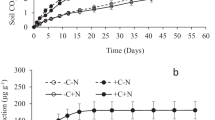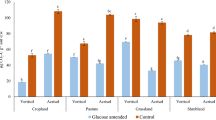Abstract
No fertilized soils (unfertilized and fallow treatments) and soils subjected to 28-year fertilization regimes, including mineral fertilization (PK and NPK) and manure amendments (NPKM and M), were incubated with or without 13C - glucose. Results showed that compared to mineral fertilization (0.64 − 0.69), the manure amendments significantly increased microbial C use efficiency (CUE) (0.76 − 0.79), mainly due to higher soil pH, lower resource stoichiometric ratios of dissolved organic C (DOC): mineral N, DOC: available P and mineral N: available P, and lower specific activities (per microbial biomass C unit) of β-1,4-glucosidase, N-acetyl-glucosaminidase and acid phosphatase. Glucose addition increased SOC mineralization, inducing positive priming effect (PE) with lower values in the manure amendments (0.11 − 0.12 mg C g−1 SOC) relative to mineral fertilization (0.25 − 0.55 mg C g−1 SOC). The PE was negatively correlated with soil pH and positively associated with resource stoichiometric ratios of DOC: mineral N, DOC: available P and mineral N: available P, mainly due to microbes mineralizing SOM to release nutrients, as indicated by the positive relationships between PE and the specific activities of N-acetyl-glucosaminidase and acid phosphatase. Concluding, relative to mineral fertilization, long-term manure amendment could increase CUE and decrease PE via alleviated soil acidification and resource limitation, thus facilitating soil C sequestration.





Similar content being viewed by others
References
Aye NS, Butterly CR, Sale PWG, Tang C (2017) Residue addition and liming history interactively enhance mineralization of native organic carbon in acid soils. Biol Fertil Soils 53:61–75
Aye NS, Butterly CR, Sale PWG, Tang C (2018) Interactive effects of initial pH and nitrogen status on soil organic carbon priming by glucose and lignocellulose. Soil Biol Biochem 123:33–44
Blagodatskaya E, Kuzyakov Y (2008) Mechanisms of real and apparent priming effects and their dependence on soil microbial biomass and community structure: critical review. Biol Fertil Soils 45:115–131
Bray RH, Kurtz LT (1945) Determination of total, organic and available forms of phosphorus in soils. Soil Sci 59:39–46
Cai A, Xu M, Wang B, Zhang W, Liang G, Hou E, Luo Y (2019) Manure acts as a better fertilizer for increasing crop yields than synthetic fertilizer does by improving soil fertility. Soil Till Res 189:168–175
Chen L, Liu L, Mao C, Qin S, Wang J, Liu F, Blagodatsky S, Yang G, Zhang Q, Zhang D, Yu J, Yang Y (2018) Nitrogen availability regulates topsoil carbon dynamics after permafrost thaw by altering microbial metabolic efficiency. Nat Commun 9:3951
Chen R, Senbayram M, Blagodatsky S, Myachina O, Dittert K, Lin X, Blagodatskaya E, Kuzyakov Y (2014) Soil C and N availability determine the priming effect: microbial N mining and stoichiometric decomposition theories. Glob Chang Biol 20:2356–2367
Cotrufo MF, Wallenstein MD, Boot CM, Denef K, Paul E (2013) The Microbial Efficiency-Matrix Stabilization (MEMS) framework integrates plant litter decomposition with soil organic matter stabilization: do labile plant inputs form stable soil organic matter? Glob Chang Biol 19:988–995
Du L, Zhu Z, Qi Y, Zou D, Zhang G, Zeng X, Ge T, Wu J, Xiao Z (2020) Effects of different stoichiometric ratios on mineralisation of root exudates and its priming effect in paddy soil. Sci Total Environ 743:140808
Fan F, Yu B, Wang B, George TS, Yin H, Xu D, Li D, Song A (2019) Microbial mechanisms of the contrast residue decomposition and priming effect in soils with different organic and chemical fertilization histories. Soil Biol Biochem 135:213–221
Fan R, Du J, Liang A, Lou J, Li J (2020) Carbon sequestration in aggregates from native and cultivated soils as affected by soil stoichiometry. Biol Fertil Soils 56:1109–1120
Fang Y, Singh BP, Collins D, Armstrong R, Van Zwieten L, Tavakkoli E (2019) Nutrient stoichiometry and labile carbon content of organic amendments control microbial biomass and carbon-use efficiency in a poorly structured sodic-subsoil. Biol Fertil Soils 56:219–233
Geyer KM, Dijkstra P, Sinsabaugh R, Frey SD (2019) Clarifying the interpretation of carbon use efficiency in soil through methods comparison. Soil Biol Biochem 128:79–88
Jones DL, Cooledge EC, Hoyle FC, Griffiths RI, Murphy DV (2019) pH and exchangeable aluminum are major regulators of microbial energy flow and carbon use efficiency in soil microbial communities. Soil Biol Biochem 138:107584
Kallenbach CM, Grandy AS, Frey SD, Diefendorf AF (2015) Microbial physiology and necromass regulate agricultural soil carbon accumulation. Soil Biol Biochem 91:279–290
Keiblinger KM, Hall EK, Wanek W, Szukics U, Hämmerle I, Ellersdorfer G, Böck S, Strauss J, Sterflinger K, Richter A, Zechmeister-Boltenstern S (2010) The effect of resource quantity and resource stoichiometry on microbial carbon-use-efficiency. FEMS Microbiol Ecol 73:430–440
Kuzyakov Y, Friedel JK, Stahr K (2000) Review of mechanisms and quantification of priming effects. Soil Biol Biochem 32:1485–1498
Lal R (2004) Soil carbon sequestration impacts on global climate change and food security. Science 304:1623–1627
Lal R, Bruce JP (1999) The potential of world cropland soils to sequester C and mitigate the greenhouse effect. Environ Sci Policy 2:177–185
Landi L, Renella G, Moreno JL, Falchini L, Nannipieri P (2000) Influence of cadmium on the metabolic quotient, L-:D-glutamic acid respiration ratio and enzyme activity: microbial biomass ratio under laboratory conditions. Biol Fertil Soils 32:8–16
Liang C, Schimel JP, Jastrow JD (2017) The importance of anabolism in microbial control over soil carbon storage. Nat Microbiol 2:17105
Luo R, Kuzyakov Y, Liu D, Fan J, Luo J, Lindsey S, He J, Ding W (2020) Nutrient addition reduces carbon sequestration in a Tibetan grassland soil: disentangling microbial and physical controls. Soil Biol Biochem 144:107764
Luo Y, Durenkamp M, De Nobili M, Lin Q, Brookes PC (2011) Short term soil priming effects and the mineralisation of biochar following its incorporation to soils of different pH. Soil Biol Biochem 43:2304–2314
Malik AA, Martiny JBH, Brodie EL, Martiny AC, Treseder KK, Allison SD (2019) Defining trait-based microbial strategies with consequences for soil carbon cycling under climate change. ISME J 14:1–9
Malik AA, Puissant J, Buckeridge KM, Goodall T, Jehmlich N, Chowdhury S, Gweon H, Peyton JM, Mason KE, Agtmaal M, Blaud A, Clark lM, Whitaker J, Pywell PF, Ostle N, Gleixner G, Griffith RI, (2018) Land use driven change in soil pH affects microbial carbon cycling processes. Nat Commun 9:1–10
Manzoni S, Taylor P, Richter A, Porporato A, Ågren GI (2012) Environmental and stoichiometric controls on microbial carbon-use efficiency in soils. New Phytol 196:79–91
Marx MC, Wood M, Jarvis SC (2001) A microplate fluorimetric assay for the study of enzyme diversity in soils. Soil Biol Biochem 33:1633–1640
Mo F, Zhang YY, Liu Y, Liao YC (2021) Microbial carbon-use efficiency and straw-induced priming effect within soil aggregates are regulated by tillage history and balanced nutrient supply. Biol Fertil Soils 57:409–420
Poeplau C, Helfrich M, Dechow R, Szoboszlay M, Tebbe CC, Don A, Greiner B, Zopf D, Thumm U, Korevaar H, Geerts R (2019) Increased microbial anabolism contributes to soil carbon sequestration by mineral fertilization in temperate grasslands. Soil Biol Biochem 130:167–176
Riggs CE, Hobbie SE (2016) Mechanisms driving the soil organic matter decomposition response to nitrogen enrichment in grassland soils. Soil Biol Biochem 99:54–65
Rousk K, Michelsen A, Rousk J (2016) Microbial control of soil organic matter mineralization responses to labile carbon in subarctic climate change treatments. Glob Chang Biol 22:4150–4161
Schimel JP, Schaeffer SM (2012) Microbial control over carbon cycling in soil. Front Microbiol 3:348
Sinsabaugh RL, Turner BL, Talbot JM, Waring BG, Powers JS, Kuske CR, Moorhead DL, Shah JJF (2016) Stoichiometry of microbial carbon use efficiency in soils. Ecol Monogr 86:172–189
Song M, Yu L, Fu S, Korpelainen H, Li C (2020) Stoichiometric flexibility and soil bacterial communities respond to nitrogen fertilization and neighbor competition at the early stage of primary succession. Biol Fertil Soils 56:1121–1135
Wei X, Zhu Z, Liu Y, Luo Y, Deng Y, Xu X, Liu S, Richter A, Shibistova O, Guggenberger G, Wu J, Ge T (2020) C:N: P stoichiometry regulates soil organic carbon mineralization and concomitant shifts in microbial community composition in paddy soil. Biol Fertil Soils 56:1093–1107
Wu J, Joergensen RG, Pommerening B, Chaussod R, Brookes PC (1990) Measurement of soil microbial biomass C by fumigation-extraction-an automated procedure. Soil Biol Biochem 22:1167–1169
Wu L, Xu H, Xiao Q, Huang Y, Suleman MM, Zhu P, Kuzyakov Y, Xu X, Xu M, Zhang W (2020) Soil carbon balance by priming differs with single versus repeated addition of glucose and soil fertility level. Soil Biol Biochem 148:107913
Wu L, Zhang W, Wei W, He Z, Kuzyakov Y, Bol R, Hu R (2019) Soil organic matter priming and carbon balance after straw addition is regulated by long-term fertilization. Soil Biol Biochem 135:383–391
Xun W, Zhao J, Xue C, Zhang G, Ran W, Wang B, Shen Q, Zhang R (2016) Significant alteration of soil bacterial communities and organic carbon decomposition by different long-term fertilization management conditions of extremely low-productivity arable soil in South China. Environ Microbiol 18:1907–1917
Zhang W, Xu M, Wang B, Wang X (2009) Soil organic carbon, total nitrogen and grain yields under long-term fertilizations in the upland red soil of southern China. Nutr Cycl Agroecosystems 84:59–69
Zhran M, Ge T, Tong Y, Deng Y, Wei X, Lynn TM, Zhu Z, Wu J, Gunina A (2021) Assessment of depth-dependent microbial carbon use efficiency in long-term fertilized paddy soil using an 18O–H2O approach. L Degrad Dev 32:199–207
Zhu Z, Ge T, Luo Y, Liu S, Xu X, Tong C, Shibistova O, Guggenberger G, Wu J (2018) Microbial stoichiometric flexibility regulates rice straw mineralization and its priming effect in paddy soil. Soil Biol Biochem 121:67–76
Funding
This work is financially supported by the National Natural Science Foundation of China (Grant Number: 41877105, 42007094 and 41907093) and the Innovation Talent Promotion Program of Ministry of Science and Technology.
Author information
Authors and Affiliations
Corresponding author
Ethics declarations
Conflict of interest
The authors declare that they have no conflicts of interest.
Additional information
Publisher’s note
Springer Nature remains neutral with regard to jurisdictional claims in published maps and institutional affiliations.
Supplementary information
ESM 1
(DOCX 298 kb)
Rights and permissions
About this article
Cite this article
Xiao, Q., Huang, Y., Wu, L. et al. Long-term manuring increases microbial carbon use efficiency and mitigates priming effect via alleviated soil acidification and resource limitation. Biol Fertil Soils 57, 925–934 (2021). https://doi.org/10.1007/s00374-021-01583-z
Received:
Revised:
Accepted:
Published:
Issue Date:
DOI: https://doi.org/10.1007/s00374-021-01583-z




